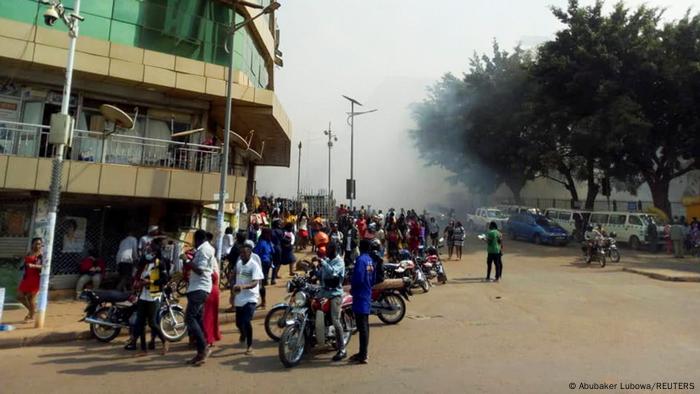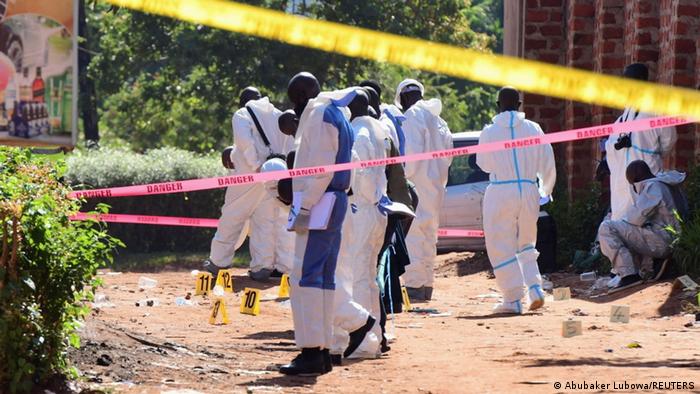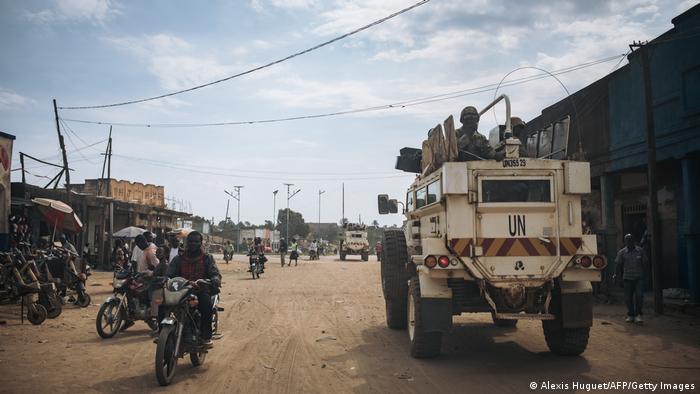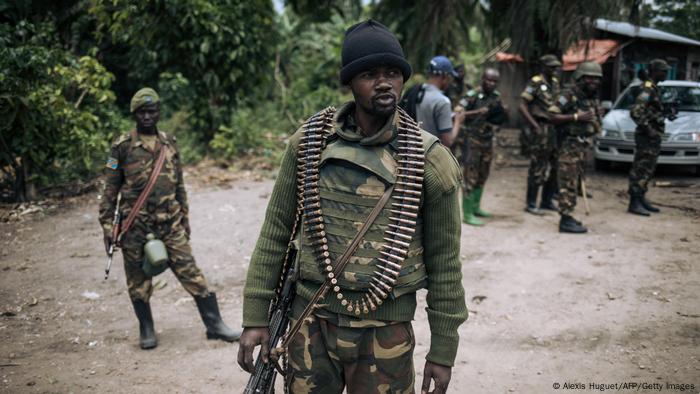ADF: What is the group is behind the deadly bombings in Uganda?
"Islamic State" claimed responsibility for the triple suicide bombing in Kampala and have named the attackers. Police have linked them to a little-known extremist group that operates along the Uganda-DR Congo border.

Bomb explosion in Uganda's capital Kampala: The Islamic State claims responsibility
The triple suicide bombing in the heart of Uganda's capital Kampala on Tuesday killed several people and injured scores more. Two blasts happened three minutes apart and sent terrified residents rushing for cover as cars burst into flames.
Police blamed the attacks on Allied Democratic Forces (ADF), a local Islamist extremist group with ties to the so-called "Islamic State" (IS). IS meanwhile took credit for the attack via its Amaq news agency on Telegram.
'Islamic State' names bombers
IS identified the bomber that carried out the first attack at a police checkpoint as Abu Sabr al-Ugandi, and gave the names of the two others who carried out a separate bombing together near the National Assembly as Abu Shahid al-Ugandi and Abu Abdul-Rahman al-Ugandi.
The Ugandan government said three civilians and three bombers were killed and 33 people were injured in the blasts.

Ugandan explosives experts secure the scene of an explosion in a Kampala suburb in October
The attacks follow two recent bombings in Kampala. Last month a number of people were wounded in a blast on a long-distance bus in Mpigi District and a woman was killed in a bombing at a roadside eatery in Komamboga.
Police said the explosions were connected and carried out by the ADF.
ADF is little understood
The blasts in Kampala shocked a nation that is known as a bulwark against violent Islamist militants in East Africa, and whose leader, Yoweri Museveni, has spent years cultivating Western security support.
But Uganda was not spared: The al Qaeda-linked Somali insurgent group al Shabaab has carried out deadly attacks there in the past, including a 2010 attack that killed 70 people.
Who is now behind the ADF group and what do they stand for? Analysts and UN experts disagree on how closely local ADF fighters actually work with the international IS network.

United Nations peacekeepers secure streets in Ochia in DRC after a terror attack by ADF
Ben Shepherd, an expert on African politics and conflict at the London-based think tank Chatham House, says the ADF is poorly understood. "There have been claims made from within the group that they are part of the IS, but we do not really know if that is true," Shepherd told DW.
There is no hierarchical leadership representing the group. The IS taking responsibility for the attacks certainly aids their propaganda war, he added.
The extent of local support for the ADF in Uganda, or the nature of its ties to the group may have across the border in the Democratic Republic of Congo, are unclear. "It is one of the least understood armed groups operating in the Great Lakes," Shepherd said.
A hybrid group embedded in DRC
The ADF has been active since 1996, formed initially as a sort of joint operation between disaffected Islamic youth who had fallen into a dispute with the Ugandan government and were pushed out of the country after trying to mobilize support.
The ADF — historically a Ugandan rebel group — became embedded in places such as North Kivu in Congo and engaged with other armed groups. The group came to be treated as one of the perhaps 120 armed groups active in eastern Congo, Shepherd said.
The group has operated alongside fighters from groups supportive of the former regimes from Milton Obote and Idi Amin who felt sidelined by Museveni's politics. ADF members have also been linked to rebels engaged in a drawn-out fight for greater independence for communities on the borders between Uganda and the DRC.
In the nearby Rwenzori Mountains, they've have been blamed for thousands of civilian deaths.
According to Shepherd, the ADF is hybrid in character: It is motivated by a Salafist and ethno-nationalist ideology and the needs of desires of the cross-border community.

Soldiers in DRC patrol in villages near Beni after an attack of the rebel group Allied Democratic Forces
It faced pressure attacks, opposition against it by the Congolese government and by UN and the Ugandan government periodically.
Why is Kampala targeted?
In recent years, the ADF has become much more of a threat to Conoglese communties, as a serious rise in violence continues. When its leader, Jamil Mukulu, was arrested in Tanzania in 2015, he was extradited to Uganda and put on trial for terrorism. The group was reduced to a few hundred fighters. Since 2019, the ADF, led by Mukulu's successor Musa Baluku, has displayed a more Islamist character.
Dino Mahtani, an analyst at the International Crisis Group, said the ADF's focus had once been on settling local scores and controlling local war economies. "With the more recent affiliation of its main faction to ISIS [Islamic State], a number of foreigners from across East Africa with more globalist jihadist agendas have been arriving into its camps," he said.
In April 2019, IS began to claim some ADF attacks on social media, presenting the group as its regional branch — the Islamic State Central Africa Province (ISCAP), which is said to stretch from Somalia to Mozambique and Congo.
In March 2021 the United States officially linked the ADF to IS. "Until we understand who the ADF are at present it is very hard to understand the motivations for the attacks that took place," analyst Ben Shepherd said.
No comments:
Post a Comment